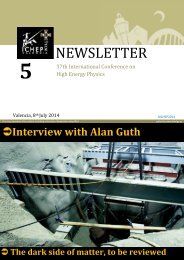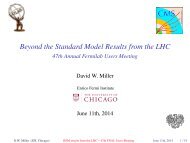PW_mar13_sample_issue
PW_mar13_sample_issue
PW_mar13_sample_issue
You also want an ePaper? Increase the reach of your titles
YUMPU automatically turns print PDFs into web optimized ePapers that Google loves.
physicsworld.com<br />
Comment: Robert P Crease<br />
Has the cultural impact of quantum<br />
mechanics been simply to supply us with a<br />
storehouse of unusual, vivid and sometimes<br />
pretentious or even loopy images?<br />
or whether any similar scrutiny of a minute<br />
section of time and space would yield similar<br />
strangenesses – gaps, inconsistencies,<br />
warps and bubbles in the surface of circumstance.<br />
Perhaps, as with the elements<br />
of matter, investigation passes a threshold<br />
of common sense and enters a subatomic<br />
realm where laws are mocked, where persons<br />
have the life-span of beta particles and<br />
the transparency of neutrinos, and where a<br />
rough kind of averaging out must substitute<br />
for absolute truth.”<br />
Years later, many frames turned out to<br />
have rational explanations. The “umbrella<br />
man” was identified – to the satisfaction of<br />
all but diehard conspiracy theorists. Testifying<br />
before a Congressional committee,<br />
the man in question said he had been simply<br />
protesting against the Kennedy family’s<br />
dealings with Hitler’s Germany, with<br />
the black umbrella – Neville Chamberlain’s<br />
trademark fashion accessory – being a symbol<br />
for Nazi appeasers. Far from heralding<br />
a breach in the rationality of the world, the<br />
umbrella man was just a heckler.<br />
Barrett, being a philosopher, had proposed<br />
that the cultural effect of quantum<br />
mechanics was to strip us of illusions.<br />
Updike, a novelist with a keen interest in<br />
science who followed contemporary developments<br />
in physics with care, reached a<br />
different conclusion. His words above indicate<br />
that he saw the impact of quantum<br />
mechanics on culture to be deeper and<br />
more positive than Barrett had. Indeed,<br />
Updike often has his fictional characters<br />
refer to physics terms in a metaphorical way<br />
that allows them to voice their experiences<br />
more articulately.<br />
The novelist was fully aware that when<br />
scientists look at the subatomic world<br />
frame by frame, so to speak, what they<br />
find is discontinuous and strange – its happenings<br />
random except when collectively<br />
considered. Updike also knew that most of<br />
us tend to find our lives following a similar<br />
crazy logic. Our world does not always<br />
feel smooth, continuous, reliable, lawgoverned,<br />
stable and substantive; close up,<br />
its palpable sensuousness is often jittery,<br />
discontinuous, chaotic, irrational, unstable<br />
and ephemeral. Reality today does not<br />
seem to have the gentle, universal continuities<br />
of the Newtonian world, but is more<br />
like that of the surface of a boiling pot of<br />
water. Using quantum language to describe<br />
everyday conditions may therefore be tech-<br />
nically incorrect but is metaphorically apt.<br />
In another essay, Updike wrote that “our<br />
century’s revelations of unthinkable largeness<br />
and unimaginable smallness, of abysmal<br />
stretches of geological time when we<br />
were nothing, of supernumerary galaxies<br />
and indeterminate subatomic behaviour,<br />
of a kind of mad mathematical violence at<br />
the heart of matter have scorched us deeper<br />
than we know”. The scorching brought<br />
about by such scientific discoveries, Updike<br />
proposed, had given birth to a “new humanism”<br />
whose “feeble, hopeless voice” is provided<br />
by the “minimal monologuists” of<br />
the Irish playwright Samuel Beckett – and<br />
which is also evident in the instantly recognizable<br />
“wire-thin, eroded figures” of the<br />
Swiss sculptor Alberto Giacometti.<br />
The critical point<br />
If only all human voices were as articulate<br />
as Beckett and Giacometti! Too frequently,<br />
the use of quantum language and concepts<br />
in popular culture amounts to what the<br />
physicist John Polkinghorne calls “quantum<br />
hype”, or the invocation of quantum<br />
mechanics as “sufficient licence for lazy<br />
indulgence in playing with paradox in<br />
other disciplines”. This is how it principally<br />
appears in things like TV programmes,<br />
cartoons, T-shirts and coffee cups.<br />
Updike’s remarks, however, suggest that<br />
quantum mechanics – a theory of awesome<br />
comprehensiveness that has yet to make an<br />
unconfirmed prediction – has does more<br />
than help to deepen our knowledge of the<br />
world and to expand our ability to manipulate<br />
it. The novelist’s remarks suggest that<br />
quantum mechanics – though a modification,<br />
not a replacement, of Newtonian<br />
mechanics – has provided us with a range<br />
of novel and helpful images to interpret our<br />
experiences of the world in a new way, on a<br />
scale equal to or possibly even greater than<br />
Newtonian mechanics. Quantum physics<br />
is metaphorically appealing because it<br />
reflects the difficulty we face in describing<br />
our own experiences; quantum mechanics<br />
is strange and so are we.<br />
Someday, indeed, the era after the Newtonian<br />
Moment may come to be known as<br />
the Quantum Moment.<br />
Robert P Crease is a professor in the Department of<br />
Philosophy, Stony Brook University, and historian<br />
at the Brookhaven National Laboratory, US,<br />
e-mail rcrease@notes.cc.sunysb.edu<br />
NEW from Amptek<br />
Digital<br />
Multichannel Analyzer<br />
The MCA8000D is a full-featured<br />
digital multichannel analyzer intended<br />
to be used with a wide variety<br />
of detector systems.<br />
The easy to use 'Pocket MCA' can fit<br />
in a shirt pocket.<br />
Features oF the MCa8000D<br />
• Compatible with traditional analog<br />
pulse shaping<br />
• MCA and MCS modes<br />
• High speed ADC (100 MHz, 16 bit) with<br />
digital pulse height measurement<br />
• 8k data channels<br />
• Minimum pulse peaking time 500 ns<br />
• Conversion time 10 ns<br />
• Sliding-scale linearization<br />
• Differential nonlinearity








